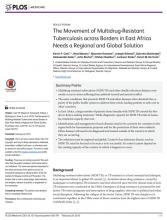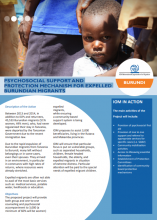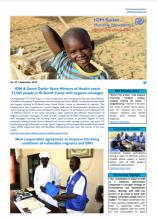Publications Search
This publications portal is a repository of all IOM migration health publications from 2006 to present where IOM was a primary contributor.
Publications include peer-reviewed scientific papers, technical reports, training guides/manuals, policy briefs/discussion papers, factsheets, newsletters, research reviews, conference and poster presentations. These are categorized by topic, author, country/region covered as well as by year, language, and type of publication. The map reflects the countries covered by the publications.
To browse or search: simply use the filter options on the left-hand side. Alternatively, you can enter keyword/s in the search box. Selecting a specific publication will lead to a ‘download’ link or link to the website where the document is housed. Here is the step-by-step guide for your reference.

Towards tuberculosis elimination: an action framework for low-incidence countries
Author/s: Lönnroth K, Migliori GB, Abubakar I, D'Ambrosio L, de Vries G, Diel R, Douglas P, Falzon D, Gaudreau MA, Goletti D, González Ochoa ER, LoBue P, Matteelli A, Njoo H, Solovic I, Story A, Tayeb T, van der Werf MJ, Weil D, Zellweger JP, Abdel Aziz M, Al Lawati MR, Aliberti S, Arrazola de Oñate W, Barreira D, Bhatia V, Blasi F, Bloom A, Bruchfeld J, Castelli F, Centis R, Chemtob D, Cirillo DM, Colorado A, Dadu A, Dahle UR, De Paoli L, Dias HM, Duarte R, Fattorini L, Gaga M, Getahun H, Glaziou P, Goguadze L, Del Granado M, Haas W, Järvinen A, Kwon GY, Mosca D, Nahid P, Nishikiori N, Noguer I, O'Donnell J, Pace-Asciak A, Pompa MG, Popescu GG, Robalo Cordeiro C, Rønning K, Ruhwald M, Sculier JP, Simunović A, Smith-Palmer A, Sotgiu G, Sulis G, Torres-Duque CA, Umeki K, Uplekar M, van Weezenbeek C, Vasankari T, Vitillo RJ, Voniatis C, Wanlin M, Raviglione MC
Abstract
This paper describes an action framework for countries with low tuberculosis (TB) incidence (<100 TB cases per million population) that are striving for TB elimination. The framework sets out priority interventions required for these countries to progress first towards “pre-elimination” (<10 cases per million) and eventually the elimination of TB as a public health problem (less than one case per million). TB epidemiology in most low-incidence countries is characterized…
Read more
Management of latent Mycobacterium tuberculosis infection: WHO guidelines for low tuberculosis burden countries
Author/s: Getahun H, Matteelli A, Abubakar I, Aziz MA, Baddeley A, Barreira D, Den Boon S, Borroto Gutierrez SM, Bruchfeld J, Burhan E, Cavalcante S, Cedillos R, Chaisson R, Chee CB, Chesire L, Corbett E, Dara M, Denholm J, de Vries G, Falzon D, Ford N, Gale-Rowe M, Gilpin C, Girardi E, Go UY, Govindasamy D, D Grant A, Grzemska M, Harris R, Horsburgh CR Jr, Ismayilov A, Jaramillo E, Kik S, Kranzer K, Lienhardt C, LoBue P, Lönnroth K, Marks G, Menzies D, Migliori GB, Mosca D, Mukadi YD, Mwinga A, Nelson L, Nishikiori N, Oordt-Speets A, Rangaka MX, Reis A, Rotz L, Sandgren A, Sañé Schepisi M, Schünemann HJ, Sharma SK, Sotgiu G, Stagg HR, Sterling TR, Tayeb T, Uplekar M, van der Werf MJ, Vandevelde W, van Kessel F, van't Hoog A, Varma JK, Vezhnina N, Voniatis C, Vonk Noordegraaf-Schouten M, Weil D, Weyer K, Wilkinson RJ, Yoshiyama T, Zellweger JP, Raviglione M
Abstract
Latent tuberculosis infection (LTBI) is characterized by the presence of immune responses to previously acquired Mycobacterium tuberculosis infection without clinical evidence of active tuberculosis (TB). Here we report evidence-based guidelines from the World Health Organization for a public health approach to the management of LTBI in high-risk individuals in countries with high or middle upper income and TB incidence of <100 per 100 000 per year. The guidelines…
Read more
Health of men, women, and children in post-trafficking services in Cambodia, Thailand, and Vietnam: an observational cross-sectional study
Author/s: Kiss L, Pocock NS, Naisanguansri V, Suos S, Dickson B, Thuy D, Koehler J, Sirisup K, Pongrungsee N, Nguyen VA, Borland R, Dhavan P, Zimmerman C
Summary
Background: Trafficking is a crime of global proportions involving extreme forms of exploitation and abuse. Yet little research has been done of the health risks and morbidity patterns for men, women, and children trafficked for various forms of forced labour.
Methods: We carried out face-to-face interviews with a consecutive sample of individuals entering 15 post-trafficking services in Cambodia, Thailand, and Vietnam. We asked participants about living and working…
Read more
The movement of multidrug-resistant tuberculosis across borders in East Africa needs a regional and global solution
Author/s: Cain KP, Marano N, Kamene M, Sitienei J, Mukherjee S, Galev A, Burton J, Nasibov O, Kioko J, De Cock KM
Summary Points
• Multidrug-resistant tuberculosis (MDR TB) and other deadly infectious diseases commonly occur in states suffering from political turmoil and armed conflict.
• The same conditions that promote MDR TB and other diseases often diminish the capacity of the public health system to address these needs, leading patients to seek care in other countries.
• In East Africa, a large number of patients from Somalia with MDR TB crossed the border to Kenya seeking…

Psychosocial Support and Protection Mechanism for Expelled Burundian Migrants
Author/s: IOM Burundi
Between 2013 and 2014, in addition to IDPs and returnees, 45,533 Burundian migrants (51% women, 49% men), who, had never regularized their stay in Tanzania, were deported by the Tanzanian Government due to the recent immigration law. Due to the rapid expulsion of Burundian migrants from Tanzania to Burundi, many left without belongings or in some cases, even their spouses. They arrived in an environment, in particular in communes with high rates of returns, where resources…
Read more
IOM e-News PHAMESA | October 2015
Author/s: IOM South Africa
At the International Dialogue on Migration: High-level Conference on Migrants and Cities, organized by IOM and held on October 26-27 in Geneva, the Migrants and cities: partnership in health panel session was presented. The conference brought ministers, high-level government officials, mayors, local authorities, the private sector and civil society organizations together to discuss the complex dynamics of human mobility at city and local levels and how risks can be managed…
Read more
IOM Sudan Monthly Newsletter | September 2015
Author/s: IOM Sudan
On September 17th IOM Sudan, in close cooperation and coordination with the State Ministry of Health’s Emergency Preparedness and Humanitarian Action (EHA), conducted one day health and hygiene training in EL-Sereif camp, South Darfur, home to thousands of migrants. The training was a joint response to a recent August outbreak of Acute Jaundice Syndrome (AJS) and an upsurge of scabies cases attributed to poor hygiene.

Ghana - Ebola Situation Report | 28 September 2015
Author/s: IOM Ghana
A 2-day training programme is being provided to build the capacity of border officials at the 8 selected Points of Entry (PoEs). The training, which is being conducted in 2 batches at each PoE, includes presentations on the Impact and Overview of Ebola Virus Disease (EVD); Surveillance for EVD and the Recognize, Isolate, Notify and Give Support (RING) Approach; EVD Preparedness and Response at PoEs; Infection Prevention and Control at PoEs; and EVD Standard Operating…
Read more
IOM e-News PHAMESA | September 2015
Author/s: IOM
The study "Health vulnerabilities of mobile populations and affected communities at the port of Dar es Salaam" has revealed that key populations working around the Port have a higher risk to contracting HIV and AIDS and STIs due to the complexities of sexual networks within their environment. The report was launched on the 22th September in Dar es Salaam and it is commissioned by the International Organization for Migration (IOM) in partnership with the South African…
Read more
The Middle East and North Africa: Annual Report 2014
Author/s: IOM
In 2014, significant flows of migration to, through and from the Middle East and North Africa continued unabated. Ongoing conflict, economic stagnation, and political turmoil were main drivers of migration, though motives for movement remain complex. Irregular migration especially for vulnerable or under-protected people such as unaccompanied minors, women and sexual minorities – exposed migrants to an array of risks as they attempted to attain physical safety…